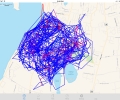Science behind the study – new publication from NBCS
Get the paper
This technical paper focuses on differences in habitat and resource use between coyotes that are “resident,” living in territorial family groups (packs), versus those that are “transient,” solitary and nomadic. Transients tend to be maturing pups, or old individuals, that leave the family territory due to social stress or food competition. We conclude that by defense of the best habitat the resident packs relegate the transients to second string, marginal, and risky habitats. The transients avoid meadows and croplands which are the favorite habitats of resident coyotes. Transients spend more time near people in residential areas than resident coyotes which generally avoid humanity by foraging and resting in natural habitats.
Citation:





